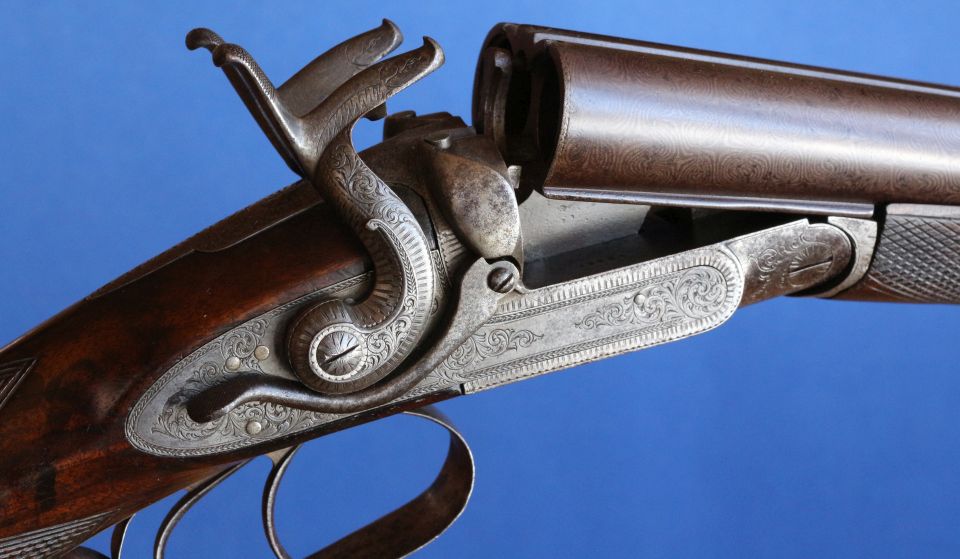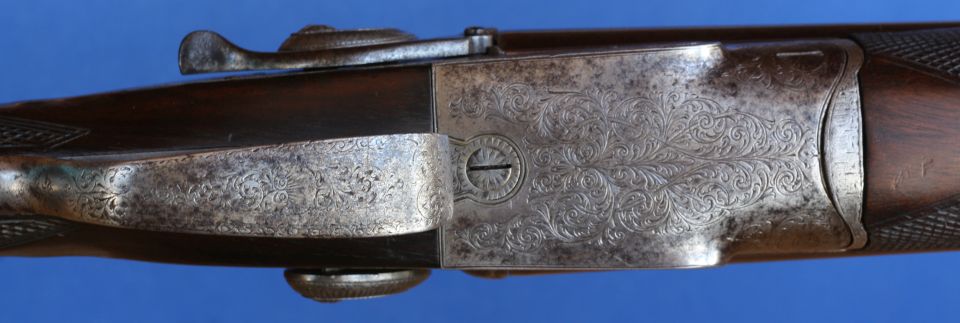With the growing popularity of the pinfire system in Britain in the mid-1860s, a number of new gunmaking firms appeared to fill the demand. One of these was the Breechloading Armoury Company Limited of London, selling guns from their fashionable 4 Pall Mall address for only a short period between 1866 and 1868.
One of their guns is shown here, a distinctive twelve-bore game gun with bar-action locks and a slender side-lever to release the breech. The hammers are nicely sculptured, and the thick fences, the radius cut between the action bar and the breech face, and the long action bar are typical features of a pinfire gun built for improved strength.
The top rib is signed “The Breech Loading Armoury Company Limited 4 Pall Mall London,” the gun carries London proofs, has 29 5/8” damascus barrels, and weights a trim 6 lb 12 oz. It has a high serial number, 10244, for a gun produced by a new company that lasted fewer than three years, suggesting it was likely obtained from an established gunmaker or supplier, with only the firm's name added to the top rib.

The very unusual action is a single-bite snap-action worked by a side lever, using part of Stephen and Joseph Law's provisional patent number 2063 of 1865. The original patent belonging to these Wolverhampton gunmakers was for an ingenious design that would release the barrel locking bolt by pulling to half-cock one of the hammers.
The patent included a pivoting locking bolt whose rounded free end engaged a hook-like barrel lump, with a vertical V-spring applying tension against the bolt. This is the locking system used on this gun (though it does not have the hammer-bolt release mechanism), and the action flats are stamped with the inscription “Law Bros Patent.” The slender side-lever, when pressed downwards, rotates and disengages the locking bolt. This is slightly different from the patent specification, but it may be that the Law brothers' hammer-bolt release design was too difficult to build or too fragile for heavy use, and was never really implemented. In practice the action works well, though the downward throw required to release the barrels is quite long and, coupled with the fragile build of the lever, one can only speculate as to how many of these levers might have been bent or broken off during a hectic pheasant drive.
this gun was built as a dual-fire gun,
Another feature of this particular gun is that it is a dual-fire, being able to use either pinfire or centrefire cartridges. In the early 1860s the pinfire gun was the dominant breechloader, and the centrefire system was starting to catch up. During this transitional period some sportsmen were unsure as to which system would eventually win out, believing a dual-fire gun offered the best solution. It appears this gun was built as a dual-fire gun, as opposed to being later modified, from the elaborate extractor mechanism built into the barrels.

The two-piece strikers appear based on Thomas George Sylven’s 1866 patent. Two holes are drilled into the breech face for each barrel, one vertical and one horizontal, meeting inside the breech face. One striker fits in the vertical hole, while the other striker slides in the horizontal hole. The upper striker is retained by a locking screw at the rear of the action, while the horizontal striker is kept in place by a plug fitted flush against the breech face. Upon being struck by the hammer, the first striker moves downwards and its angled tip transfers its energy to the second striker, which moves forward and explodes the cap. Should a pinfire cartridge be inserted instead, the hammer nose would strike the pin and explode the charge before the hammer would reach the centre-fire striker. The centrefire cartridge soon became as readily available as the pinfire cartridge, and the need for dual-ignition guns disappeared.
The story of the company is quite interesting. It starts with the Birmingham gunmakers Bertram Calisher and William Terry, and their capping-breechloader carbine of 1856. The carbine had a very limited service use with the British 18th Hussars from 1859 to 1864, after which the same rifles were re-issued to the Cape Mounted Rifles. In addition, some rifles were built for sporting use. In April 1865 Calisher and Terry sold their patents and their London and Birmingham premises to a new concern, which was to operate under the name The Breech Loading Armoury Company.
The new company was incorporated in May of that year, and it aimed to build and market the carbine and other guns. It offered a widely-advertised prospectus to attract investors, making available 6,000 shares at a cost of £25 each. The Chairman of the new company was Rear-Admiral Mark John Currie, who had played a significant role in the exploration of Australia and the foundation of the Swan River Colony, later named Western Australia.
it was shown that the prospectus shown to investors had a number of gross misstatements,
However, in July 1866 a shareholder took the company to court, accusing it of fraud. While the role or responsibility of the company directors in the matter was never established, the court saw fit to order the winding down of the company in July 1866. In court it was shown that the prospectus shown to investors had a number of gross misstatements, such as the Calisher & Terry rifles built by the company had been approved and adopted by the government and supplied to the cavalry forces (the British government had only agreed to a trial of the rifles); English, French, American, Austrian and Belgian patents had been obtained (only one English patent had been obtained); several large payments had been made to the company (none had been made); and that 35,000 rifles had been supplied to the Government of New Zealand (which was not the case).
Master of the Rolls Lord Romilly, the judge in the case, stated “I must confess that the statements in the prospectus of this company are beyond anything the worst I have ever met with. The mis-statements are the most wanton I ever saw.” Not surprisingly, the legal case of The Breech Loading Armoury Company was covered in the British press at the time. Perhaps of relevance to the gun above is the following notice in the London newspaper “The Sportsman” of 22 October 1867:

“MESSRS JOHNSON AND DYMOND have received instructions to SELL, as above, on Thursday, October 24, at twelve precisely (in the large room, on the first floor), the last of the remaining portion of the STOCK of the late BREECH-LOADING ARMOURY COMPANY, now in the course of winding up; consisting of patent central-fire shot guns of every description, 120 best regulation muzzle-loading carbines, a selection of sporting rifles, Deane, Hardinge, and Deane’s, Colt’s, and Lefaucheux revolvers, and miscellaneous stock.”
The actual maker of the gun pictured here is likely to remain unknown, and if a reader has ever seen another Law Bros action, or Breech Loading Armoury Company game gun, I would like to hear about it. How a little-used patent appeared on a well-made gun likely built on contract to a company that just retailed the gun is a mystery. Was it a special request? A marketing attempt, to attract clients or investors? Why use such a little-known patent, when so many others were better, and readily available? The lack of any others turning up makes it impossible to tell.
Stephen Nash
Published by Vintage Guns Ltd on




